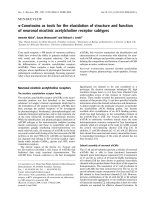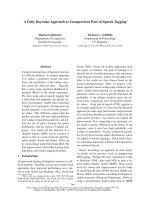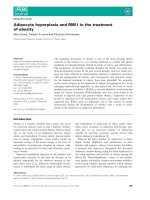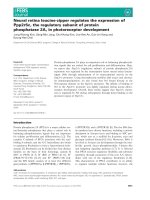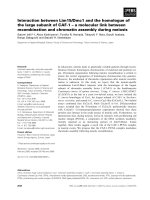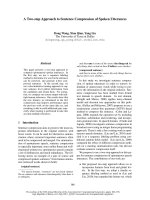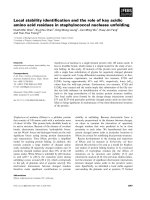Báo cáo khoa học: "Speech Technology: from Research to the Industry of Human-Machine Communication" potx
Bạn đang xem bản rút gọn của tài liệu. Xem và tải ngay bản đầy đủ của tài liệu tại đây (35.83 KB, 1 trang )
Tutorial Abstracts of ACL-08: HLT, page 5,
Columbus, Ohio, USA, June 2008.
c
2008 Association for Computational Linguistics
Speech Technology:
from Research to the Industry of Human-Machine Communication
Roberto Pieraccini
SpeechCycle
26 Broadway, 11
th
Floor
New York, NY 10004
1 Introduction
This tutorial is about the evolution of speech technology
from research to a mature industry. Today, spoken lan-
guage communication with computers is becoming part
of everyday life. Thousands of interactive applications
using spoken language technology— known also as
“conversational machines”—are only phone calls away,
allowing millions of users each day to access informa-
tion, perform transactions, and get help. Speech recog-
nition, language understanding, text-to-speech
synthesis, machine learning, and dialog management
enabled this revolution after more than 50 years of re-
search. The industry of speech continues to mature with
its evolving standards, platforms, architectures, and
business models within different sectors of the market.
2 Content Overview
In this tutorial I will briefly trace the history of speech
technology, with a special focus on speech recognition
and spoken language understanding, from the early at-
tempts to today’s commercial deployments. I will sum-
marily describe the most successful ideas and
algorithms that brought to today’s technology. I will
discuss the struggle for ever increasing performance, the
importance of data for training and evaluation, and the
role played by government funded projects in creating
effective evaluation benchmarks. I will then describe the
birth of the speech industry in the mid 1990s, with the
role played by the Voice User Interface and dialog en-
gineering disciplines in bringing speech recognition
from a laboratory “accuracy challenge” to an enabler of
usable interfaces. I will describe the rising of standards
(such as VoiceXML, SRGS, SSML, etc.) and their im-
portance in the growth of the market. I will proceed
with an overview of the current architectures and proc-
esses utilized for creating commercial spoken dialog
systems, and will provide several case studies of the use
of speech technology. I will conclude with a discussion
on the current open problems and challenges.
The tutorial duration will be of about 3 hours with a
short break. Several audio and video samples will be
shown during the tutorial. The tutorial is directed to a
general HLT audience with no prior knowledge of
speech technology.
3 Tutorial Outline
- What is speech and why it is difficult to recog-
nize it.
- The history of speech recognition from the
early attempts to Hidden Markov Models
- The struggle for performance and the impor-
tance of data
- Spoken language understanding and dialog
- The birth of the “spoken dialog” industry
- Industrial standards and architectures
- Case studies
- Open issues and future research
References
Pieraccini, R. Huerta, J., Where do we go from here?
Research and Commercial Spoken Dialog Systems,
Proc. of 6
th
SIGdial Workshop on Discourse and Dia-
log, Lisbon, Portugal, 2-3 September, 2005. pp. 1-10
Pieraccini R., Lubensky, D., Spoken Language Commu-
nication with Machines: the Long and Winding Road
from research to Business, in M. Ali and F. Esposito
(Eds) : IEA/AIE 2005, LNAI 3533, pp 6-15, 2005,
Springer-Verlag
5

